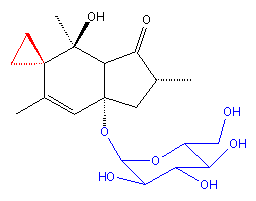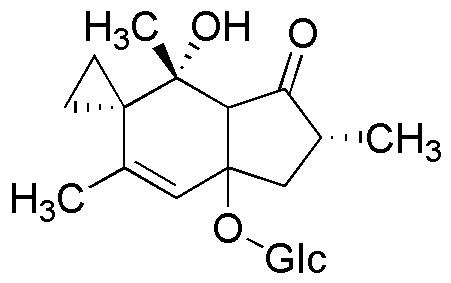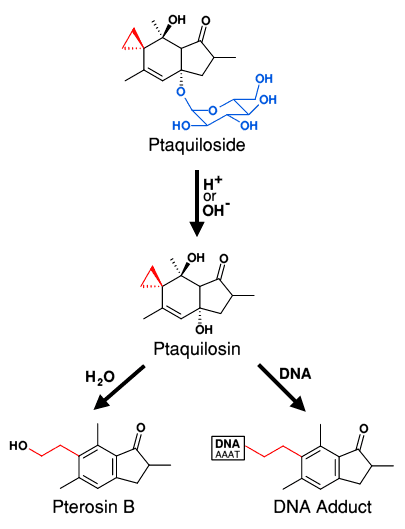 | ||
Ptaquiloside is the major toxin of bracken, and was first isolated in 1983. Its chemical stereostructure was determined to be norsesquiterpene glucoside of illudane type by Yamada and co-workers.

The carcinogenicity of ptaquiloside was proven in 1984, and ptaquiloside was shown to be responsible for the characteristic biological effects of bracken, such as acute bracken poisoning, bright blindness in sheep, mutagenicity, clastogenic effects and genotoxicity.

In a weakly alkaline solution, ptaquiloside is gradually converted, with concomitant elimination of glucose, into an unstable compound “dienone”, which is the activated form of ptaquiloside and acts as a powerful alkylating agent. The “dienone” alkylates the purine bases (adenine and guanine) of DNA, and then the alkylated purine parts are spontaneously removed from DNA: subsequently the cleavage of DNA occurs (DNA damage). Prakash and co-workers suggested ptaquiloside-induced carcinogenesis was initiated by the activation of the H-Ras oncogene.

From the chemical and ecological viewpoints, quantitative analyses of ptaquiloside in bracken were intensively performed worldwide. The ptaquiloside content of bracken proved to vary: for example, concentrations of ptaquiloside in the dried fronds of bracken were 0.1-0.6%.

In 2004, Danish scientist Lars Holm Rasmussen released a study showing the chemical can leach from the plant into the water supply, which may explain an increase in the incidence of gastric and oesophageal cancers in humans in bracken-rich areas. In addition, livestock have been known to eat the young shoots and fronds, which can then cause cancer in the animals, especially when untreated. Ptaquiloside has been identified in the milk of cows and groundwater. Humans can be exposed by direct consumption of the plant, contaminated water or milk, and spore inhalation.

It has been suggested that selenium supplementation can prevent as well as reverse the immunotoxic effects induced by ptaquiloside.
